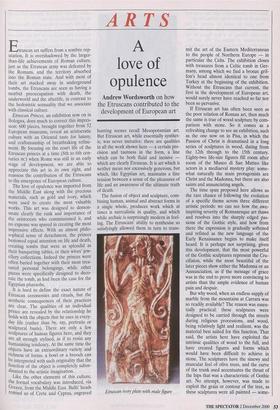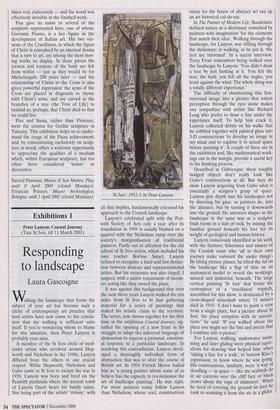love of opulence
Andrew Wordsworth on how the Etruscans contributed to the development of European art Etruscan art suffers from a sombre rep- utation. It is overshadowed by the larger- than-life achievements of Roman culture, just as the Etruscan army was defeated by the Romans, and the territory absorbed into the Roman state. And with most of their art stacked away in underground tombs, the Etruscans are seen as having a morbid preoccupation with death, the underworld and the afterlife, in contrast to the hedonistic sensuality that we associate with classical culture.
Etruscan Princes, an exhibition now on in Bologna, does much to correct this impres- sion: 600 pieces, brought together from 52 European museums, reveal an aristocratic culture with an Oriental taste for luxury, and craftsmanship of breathtaking refine- ment. By focusing on the court life of the Etruscan princes at a time (8th to 6th cen- turies BC) when Rome was still in an early stage of development, we are able to appreciate this art in its own right, and reassess the contribution of the Etruscans to the emergence of European culture. The love of opulence was imported from the Middle East along with the precious materials, such as gold and ivory, which were used to create the most valuable works. This art was designed to demon- strate clearly the rank and importance of the aristocrats who commissioned it, and 110 expense was spared in creating the most Impressive effects. With an almost philo- sophical sense of detachment, the princes bestowed equal attention on life and death, creating tombs that were as splendid as their banqueting tables, or their wives' jew- ellery collections. Indeed the princes were often buried together with their most trea- sured personal belongings, while other Pieces were specifically designed to deco- rate the tomb, as had been the case for the Egyptian pharaohs. It is hard to define the exact nature of Etruscan ceremonies and rituals, but the aesthetic consequences of their practices are clear. The qualities of an individual Prince are revealed by the relationship he holds with the objects that he uses in every- day life (rather than by, say, portraits or sculptural busts). There are only a few sculptures of human figures here, and they are all strongly stylised, as if to resist any humanising tendency. At the same time the Objects have an extraordinary variety and richness of forms: a bowl or a brooch can be interpreted with such originality that the function of the object is completely subor- dinated to the artistic imagination.
Like the other elements of this culture, the formal vocabulary was introduced, via Greece, from the Middle East. Bulls' heads remind us of Crete and Cyprus, engraved hunting scenes recall Mesopotamian art. But Etruscan art, while essentially synthet- ic, was never imitative: there are qualities in all the work shown here — a certain pre- cision and tautness in the form, a line which can be both fluid and incisive — which are clearly Etruscan. It is art which is neither mean nor excessively generous, but which, like Egyptian art, maintains a fine tension between a sense of the pleasures of life and an awareness of the ultimate truth of death.
The fusion of object and sculpture, com- bining human, animal and abstract forms in a single whole, produces work which at times is surrealistic in quality, and which while archaic is surprisingly modern in feel- ing. The Etruscans' ability to synthesise so satisfyingly allowed them in turn to trans- mit the art of the Eastern Mediterranean to the people of Northern Europe — in particular the Celts. The exhibition closes with treasures from a Celtic tomb in Ger- many, among which we find a bronze grif- fon's head almost identical to one from Turkey at the beginning of the exhibition. Without the Etruscans that current, the first in the development of European art, would surely never have reached so far nor been so pervasive.
If Etruscan art has often been seen as the poor relation of Roman art, then much the same is true of wood sculpture by com- parison with stone. So it comes as a refreshing change to see an exhibition, such as the one now on in Pisa, in which the Passion of Christ is dramatised in a long series of sculptures in wood, dating from the 12th through to the 15th century. Eighty-two life-size figures fill room after room of the Museo di San Matteo like actors in a mediaeval mystery play: some- what naturally the main protagonists are Christ and the Madonna, but there are also saints and annunciating angels.
The time span proposed here allows us the rare chance of following the evolution of a specific theme across three different artistic periods: we can see how the awe- inspiring severity of Romanesque art thaws and resolves into the sharply edged pas- sions of the Gothic style, and how from there the expression is gradually softened and refined as the new language of the Early Renaissance begins to make itself heard. It is perhaps not surprising, given this development, that the most powerful of the Gothic sculptures represent the Cru- cifixion, while the most beautiful of the later pieces show either the Madonna or an Annunciation, as if the message of grace was in the end to prove more convincing to artists than the ample evidence of human pain and despair.
But why wood, when an endless supply of marble from the mountains at Carrara was so readily available? The reason was essen- tially practical: these sculptures were designed to be carried through the streets during religious processions, and wood, being relatively light and resilient, was the material best suited for this function. That said, the artists here have exploited the intrinsic qualities of wood to the full, and have created figures and forms which would have been difficult to achieve in stone. The sculptures have the sinewy and muscular feel of olive trees, and the curve of the trunk used accentuates the thrust of the hips that was a characteristic of Gothic art. No attempt, however, was made to exploit the grain or contour of the tree, as these sculptures were all painted — some- times very elaborately — and the wood was effectively invisible in the finished work.
Pisa gave its name to several of the sculptors represented here, one of whom, Giovanni Pisano, is a key figure in the development of Italian art. His two ver- sions of the Crucifixion, in which the figure of Christ is convulsed by an internal drama that is new to art, are among the most mov- ing works on display. In these pieces the torsion and tensions of the body are felt from within — just as they would be for Michelangelo 200 years later — and the relationship of Christ to the Cross is also given powerful expression: the arms of the Cross are placed in diagonals to rhyme with Christ's arms, and are carved as the branches of a tree (the Tree of Life) to remind us, perhaps, that Christ died so that we could live.
Pisa and Siena, rather than Florence, were the centres for Gothic sculpture in Tuscany. This exhibition helps us to under- stand the range of the Pisan achievement; and, by concentrating exclusively on sculp- ture in wood, offers a welcome opportunity to appreciate the qualities of a medium which, within European sculpture, has too often been considered 'minor' or decorative.
Sacred Passions, Museo di San Matteo, Pisa, until 8 April 2001 (closed Mondays). Etruscan Princes; Museo Archeologico, Bologna, until 1 April 2001 (closed Mondays).



















































































 Previous page
Previous page